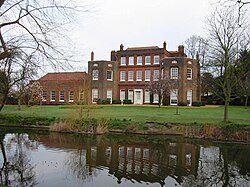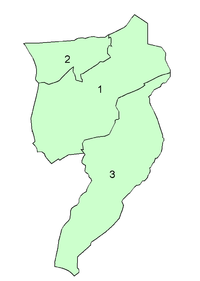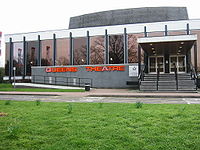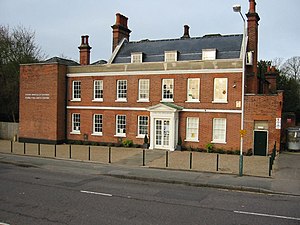Hornchurch: Difference between revisions
Created page with '{{Infobox town |name=Hornchurch |county=Essex |picture=Langtons house london.jpg |picture caption=Langtons House |latitude=51.556503 |longitude=0.212812 |LG district=Haver…' |
|||
| Line 32: | Line 32: | ||
Historically, the parish was conterminous with the Royal Manor and Liberty of Havering-atte-Bower,<ref name=vision>[http://www.visionofbritain.org.uk/relationships.jsp?u_id=10199463&c_id=10001043 Vision of Britain] - Havering atte Bower liberty</ref> with Hornchurch village - then known as Suttons Manor, located in the south of the area. From the time of Edward the Confessor, the land was in royal ownership - passing to William the Conqueror at the conquest. In 1086, the name Havering was applied to the entire district.<ref name=Brit/> | Historically, the parish was conterminous with the Royal Manor and Liberty of Havering-atte-Bower,<ref name=vision>[http://www.visionofbritain.org.uk/relationships.jsp?u_id=10199463&c_id=10001043 Vision of Britain] - Havering atte Bower liberty</ref> with Hornchurch village - then known as Suttons Manor, located in the south of the area. From the time of Edward the Confessor, the land was in royal ownership - passing to William the Conqueror at the conquest. In 1086, the name Havering was applied to the entire district.<ref name=Brit/> | ||
===Modern | ===Modern age=== | ||
[[File:Queens theatre hornchurch.jpg|right|thumb|200px|Queen's Theatre]] | [[File:Queens theatre hornchurch.jpg|right|thumb|200px|Queen's Theatre]] | ||
During both the First World War and Second World War nearby Hornchurch Airfield was an important RAF station; it was known as RAF Suttons Farm during the Great War, with its HQ as far away as Upminster Hall. During the Second World War, the airfield was known as RAF Hornchurch, and was home mostly to a number of Spitfire squadrons, with an advanced sub-station at Rayleigh. The land has since been reused for a large housing development and Hornchurch Country Park. Like most suburbs of London, Hornchurch had been entirely rural until the arrival of the railway which spurred huge property development during the early 1900s. Whole estates were constructed such as Emerson Park to the north. Development was fuelled further by the arrival of the electrified District Line during the 1930s with inter and post war housing developments south and west of Hornchurch in places such as Elm Park. | During both the First World War and Second World War nearby Hornchurch Airfield was an important RAF station; it was known as RAF Suttons Farm during the Great War, with its HQ as far away as Upminster Hall. During the Second World War, the airfield was known as RAF Hornchurch, and was home mostly to a number of Spitfire squadrons, with an advanced sub-station at Rayleigh. The land has since been reused for a large housing development and Hornchurch Country Park. Like most suburbs of London, Hornchurch had been entirely rural until the arrival of the railway which spurred huge property development during the early 1900s. Whole estates were constructed such as Emerson Park to the north. Development was fuelled further by the arrival of the electrified District Line during the 1930s with inter and post war housing developments south and west of Hornchurch in places such as Elm Park. | ||
Revision as of 09:59, 5 August 2014
| Hornchurch | |
| Essex | |
|---|---|
 Langtons House | |
| Location | |
| Grid reference: | TQ535865 |
| Location: | 51°33’23"N, -0°12’46"E |
| Data | |
| Post town: | Hornchurch |
| Postcode: | RM11, RM12 |
| Dialling code: | 01708 |
| Local Government | |
| Council: | Havering |
| Parliamentary constituency: |
Hornchurch and Upminster |
Hornchurch is a large suburban town in Essex, somewhat contiguous with the towns gathered around Romford.
The town comprises a number of shopping streets and a large residential area. It historically formed part of the Royal Liberty of Havering.
The economic history of Hornchurch is underpinned by a shift away from agriculture to other industries and the growing significance of nearby Romford as a market town and centre of administration. As part of the suburban growth of London in the 20th century, Hornchurch significantly expanded and increased in population.
The River Ingrebourne forms the boundary with Upminster to the east. Hornchurch borders Romford to the northwest and Rainham to the south.
Name
The name of Hornchurch may be derived from that of the monastery which once stood here and that derived in turn form the mother abbey in Savoy, named Monasterium Cornutum ("Horned Monastery"). The earliest recorded name for the town is found in 1222 and it was recorded as "Hornechurch" in 1233. (The horned bull's head mounted on the eastern end of St Andrew's Church near the town centre dates from much later, around the 18th Century.)
History

Origins
Stone Age tools, Bronze Age and Iron Age artefacts have been discovered in Hornchurch, indicating a lengthy occupation in pre-history. Roman remains, sufficient to indicate a settlement have also been found in South Hornchurch.[1] Hornchurch originates from around the 12th century when Henry II gave 1,500 acres to the hospice of St Nicholas and St Bernard, Mountjoux, in Savoy as a gift.[1] A prosperous priory and church were established in Hornchurch, near the parish church, but the monks were forced out during the 14th century when a new law banned foreign land ownership. The lands were then given to Lord Chancellor William of Wykeham who made major renovations to the church. He subsequently gave Hornchurch to endow New College, Oxford, which still owns all the local church lands and buildings. Due to this, Saint Andrew's Church was not adopted into the Diocese of Chelmsford until agreement was reached in the 1930s. The parish remains staffed by a vicar temporal and his curates.
Historically, the parish was conterminous with the Royal Manor and Liberty of Havering-atte-Bower,[2] with Hornchurch village - then known as Suttons Manor, located in the south of the area. From the time of Edward the Confessor, the land was in royal ownership - passing to William the Conqueror at the conquest. In 1086, the name Havering was applied to the entire district.[1]
Modern age

During both the First World War and Second World War nearby Hornchurch Airfield was an important RAF station; it was known as RAF Suttons Farm during the Great War, with its HQ as far away as Upminster Hall. During the Second World War, the airfield was known as RAF Hornchurch, and was home mostly to a number of Spitfire squadrons, with an advanced sub-station at Rayleigh. The land has since been reused for a large housing development and Hornchurch Country Park. Like most suburbs of London, Hornchurch had been entirely rural until the arrival of the railway which spurred huge property development during the early 1900s. Whole estates were constructed such as Emerson Park to the north. Development was fuelled further by the arrival of the electrified District Line during the 1930s with inter and post war housing developments south and west of Hornchurch in places such as Elm Park.
Transport

The stations in the town are Upminster Bridge tube station, Hornchurch tube station, Elm Park tube station and Emerson Park railway station. The nearest main line railway station is at Upminster.
Sport
- Football: AFC Hornchurch
- Hockey: Havering Hockey Club (formerly Hornchurch Hockey Club)
References
- ↑ 1.0 1.1 1.2 Hornchurch: Introduction - A History of the County of Essex: Volume 7 (1978), pp. 25-31
- ↑ Vision of Britain - Havering atte Bower liberty